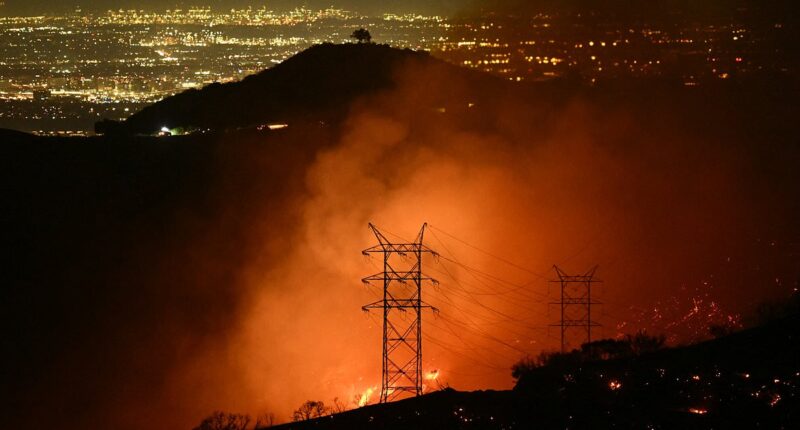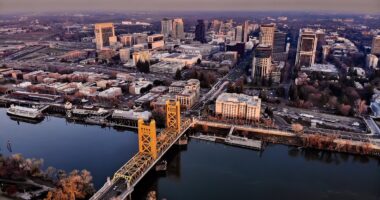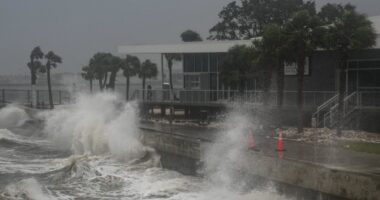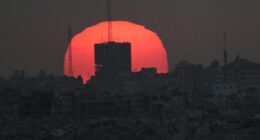Energy company Edison International is being investigated over a possible link to one of the wildfires currently tearing through Los Angeles.
The $25 billion firm disclosed the discovery of a downed conductor at a tower near the origin of the Hurst Fire that ignited during a strong Santa Ana wind event on Tuesday evening.
However, Edison said it doesn’t know whether the damage happened before or after the fire, which has so far burned through almost 800 acres of land.
This conductor was identified at the Eagle Rock Sylmar 220 kV circuit, as stated in a press release issued by the company on Sunday. The company also mentioned that these findings are preliminary in nature.
Edison International has seen its market capitalization drop significantly by $5.73 billion within the past week, declining from $30.89 billion on January 3 to $25.16 billion today.
The wildfires have put pressure on energy, utility and insurance firm shares more broadly, sending the stock market haywire. Edison shares plummeted 10 percent on Wednesday and 6.5 percent on Friday.
It comes as speculation swirls about what could have caused the worst cluster of wildfires ever seen in the United States – and Los Angelinos, who have lost everything, are demanding answers.

Energy company Edison International is being investigated over a possible link to one of the wildfires currently tearing through Los Angeles

It comes as speculation swirls about what could have caused the worst cluster of wildfires ever seen in the United States and Los Angelinos who have lost everything are demanding answers

The $25 billion firm said it discovered a downed conductor at a tower. (Pictured: Edison International CEO Pedro J. Pizarro taking a tour of a fuel storage installation in California with the U.S. Secretary of Energy Jennifer Granholm and U.S. Rep. Mike Levin in 2022)
Faults along the LA power grid soared earlier this week. Bob Marshall, the chief executive of Whisker Labs, a company that monitors electrical activity, told Fox News that the firm saw spikes in the hours before each of the fires.
Marshall said data shows the power was not immediately shut off after the faults surged, and may have been caused by ‘tree limbs touching wires or wires blowing in the wind and touching.’
‘That creates a spark in a fault, and we detect all of those things,’ Marshall said. Faulty electrical equipment, a sudden surge in electrical demand or earthquake tremors are also possible causes of the surges.
In the worst-hit Pacific Palisades area, there were 63 faults in the two-to-three hours before it ignited, with 18 coming in the hour before it started Tuesday.
The Eaton Fire, near Altadena, saw 317 grid faults in the hours before ignition, Marshall said, and the Hurst Fire saw around 230 faults. On a typical day, he said the company registers very few.
Although investigators have yet to determine the cause of the fires, the grid faults raise the possibility that sparks from the faults ignited dried-out vegetation, with high winds then carrying embers across the region.
Edison, which is potentially linked to the Hurst Fire, is owned by a mix of individual investors and public companies.
The Hurst Fire has been burning through San Fernando in Los Angeles County. The blaze was 89 percent contained as of 2pm on Sunday, according to the California Department of Forestry and Fire Protection.
It’s one of the three main active fires, though the other two are even larger. The Eaton Fire had torn through more than 14,000 acres north of Pasadena by 2pm on Sunday and was only 27 percent contained.
Meanwhile, the Palisades Fire had razed almost 24,000 acres by the same time and was only 11 percent contained.
So far, the California fires have killed at least 16 people, while wiping out an estimated 29,000 acres of land and 12,300 structures.
They have also caused around $57 billion in economic damage and forced 180,000 people to evacuate.
Fierce Santa Anas have been largely blamed for turning the wildfires sparked last week into infernos that leveled entire neighborhoods around the city where there has been no significant rainfall in more than eight months.
The National Weather Service issued red flag warnings for severe fire conditions continuing from Sunday through Wednesday, with sustained winds of 50mph and gusts in the mountains reaching 70 mph.

Pictured: Pedro J. Pizarro, President and C.E.O. of Edison International, speaks onstage at The New York Times Climate Forward Summit 2023 at The Times Center in NYC in September 2023

Pictured: A firefighter keeps watch for structure defense against the Palisades wildfire in Los Angeles, California, USA, 11 January 2025
The most dangerous day will be Tuesday, according to weather service meteorologist Rich Thompson.
‘You’re going to have really strong gusty Santa Ana winds, a very dry atmosphere and still very dry brush, so we still have some very critical fire weather conditions out there,’ Thompson said at a community meeting Saturday night.
Los Angeles County Fire Chief Anthony C. Marrone said 70 additional water trucks arrived to help crews fend off flames spread by renewed gusts. ‘We are prepared for the upcoming wind event,’ he said.
Officials were building an online database to allow evacuated residents to see if their homes were damaged or destroyed. In the meantime, LA city Fire Chief Kristin Crowley urged people to stay away from scorched neighborhoods.
‘There are still active fires that are burning within the Palisades area, making it extremely, extremely dangerous for the public,’ Crowley said at a Sunday briefing.
‘There’s no power, there’s no water, there’s broken gas lines, and we have unstable structures. The first responders are working as quickly as possible to ensure that it is safe for you to return into your communities.’
Officials warned the ash can contain lead, arsenic, asbestos and other harmful materials.
About 150,000 people in Los Angeles County remained under evacuation orders, with more than 700 residents taking refuge in nine shelters, Luna said.
By Sunday morning, Cal Fire reported the Palisades, Eaton, Kenneth and Hurst fires had consumed more than 62 square miles, an area larger than San Francisco.

















